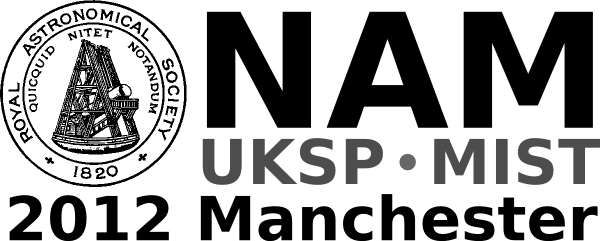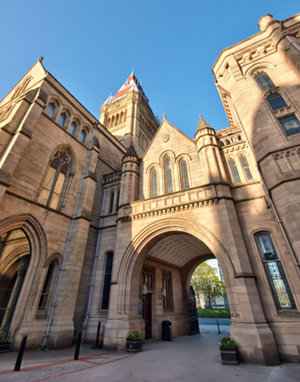UK-Germany National Astronomy Meeting NAM2012
Met Office to Provide Space Weather Warnings for Planet Earth and Forecasts for Exoplanets
Royal Astronomical Society press release
RAS PR 12/ 22 (NAM 13)
29 March 2012

The Earth's upper atmosphere, as seen by the Space Shuttle Discovery during the STS-96 mission in 1999.
The UK Met Office's weather and climate model is being adapted to help understand space weather at Earth and the atmospheres of planets orbiting other stars. Two teams of scientists will present their work at the National Astronomy Meeting in Manchester.
The Met Office plans to expand its services to provide operational space weather forecasts for the UK. It is pooling skills with the UK's space weather research community to extend its 'Unified Model' upwards to include the Earth's thermosphere, a region about 90-600km above the Earth surface. The impact of space weather events is very commonly seen in this region.
"Space weather can affect the aviation and power industries, as well as a whole range of activities that rely on GPS timing and positioning, radio communication or satellite-based observations," said the Met Office's Dr David Jackson, who will present the project on Friday 30th March.
"To develop a more accurate and useful advanced-warning system for space weather, we need to develop a system of interconnected models that describe the whole domain - the conditions on the Sun, interplanetary space, the layers of the Earth's atmosphere, all the way down to the Earth's surface. The more accurate we can be in representing interactions between the lower atmosphere and thermosphere, the more we can enhance thermospheric forecasts, and thus improve space weather forecast products for users," Jackson continued.
A second team of researchers is adapting the Unified Model for extra-solar planet climatology - the study of atmospheric properties of planets orbiting other stars. The team, led by Prof Isabelle Baraffe of Exeter University, comprises astrophysicists, climate scientists and meteorologists.
"The Met Office has developed a sophisticated tool for Earth weather forecasting and climate studies. It could be of vital importance in the interpretation the wealth of observational data on extra-solar planets we expect to come within the next decade," said Dr David Acreman, who will present the project at the National Astronomy Meeting on Thursday 29th March.
"Most of the hundreds of extra-solar planets discovered to date are gas giants orbiting very close to their host star. These planets are strongly irradiated by the parent star, with one side experiencing permanent day and the other in permanent night. The day side of the planet is much hotter than the night side and this temperature difference causes high speed winds to flow. These winds can be as fast as a few kilometers per second. Although these conditions are unlike anything seen on Earth, the Unified Model is capable of handling these extreme circumstances," said Acreman, who is part of the Astrophysics group at the University of Exeter.
The project aims to help understand the redistribution of heat from the dayside to the nightside, determine the key parameters affecting the efficiency of such heat redistribution and study the deep circulation patterns driven by the winds and their effects on the planet's internal structure. In the longer term, the project will be extended to the study of Earth-like exoplanet atmospheres, where conditions may resemble those found in the early or present day Solar System, and to the determination of biosignatures, potentially revealing the presence of a biosphere and life.
Future observational projects will shed new light on extra-solar planets, but interpreting the data will require an increased understanding of the planets being observed.
"By adapting the Met Office model to the conditions found on those planets we can interpret these observations, and use them to understand how the physics governing our weather and climate behaves in an environment very different from our own," explained Nathan Mayne of the University of Exeter. "The feedback will provide valuable tests of our numerical models under extreme conditions and demonstrate its adaptability and robustness."
IMAGES
The Earth's upper atmosphere, as seen by the Space Shuttle Discovery during the STS-96 mission in 1999. http://www.nasa.gov/multimedia/imagegallery/image_feature_324.html
Artist's impression of exoplanet HAT-P-7b. Credit: ESA/NASA/G. Bacon (STScI): http://www.spacetelescope.org/images/ann1114a/
MEDIA CONTACTS
NAM 2012 Press Office (0900 - 1730 BST, 27-29 March; 0900 - 1630 BST 30 March)
Room 3.214
University Place building
University of Manchester
Manchester
UK
Tel: +44 (0)161 306 7313
Dr Robert Massey
Royal Astronomical Society
Mob: +44 (0)794 124 8035
Email: rm@ras.org.uk
Anita Heward
Royal Astronomical Society
Mob: +44 (0)7756 034 243
Email: anitaheward@btinternet.com
Dr Klaus Jaeger
Pressereferent / Press Officer im Vorstand der Astronomischen Gesellschaft
Tel: +49 6221 528 379
Email: pressereferent@astronomische-gesellschaft.de
Dan Cochlin
Media Officer (Faculty of Engineering and Physical Sciences)
University of Manchester
Tel: +44 (0)161 275 8387
Email: daniel.cochlin@manchester.ac.uk
SCIENCE CONTACTS
Dr David Jackson
Manager of Stratosphere and Large Scale Dynamics
Met Office
FitzRoy Road
Exeter
Devon EX1 3PB United Kingdom
Tel: +44 (0)1392 884530
Email: david.jackson@metoffice.gov.uk
Website: http://www.metoffice.gov.uk/
Dr. David Acreman,
Research Fellow,
School of Physics,
University of Exeter,
Stocker Road,
Exeter EX4 4QL
Email: acreman@astro.ex.ac.uk
Web: www.astro.ex.ac.uk/people/acreman
Telephone: 01392 725520
NOTES FOR EDITORS
NAM 2012
Bringing together more than 900 astronomers and space scientists, the National Astronomy Meeting (NAM 2012) will take place from 27-30 March 2012 in the University Place conference centre at the University of Manchester in the UK. The conference is a joint meeting of the Royal Astronomical Society (RAS) and the German Astronomische Gesellschaft (AG) and is held in conjunction with the UK Solar Physics (UKSP: www.uksolphys.org) and Magnetosphere Ionosphere Solar Terrestrial (MIST: www.mist.ac.uk) meetings. NAM 2012 is principally sponsored by the RAS, AG, STFC and the University of Manchester.
The Royal Astronomical Society
The Royal Astronomical Society (RAS: www.ras.org.uk), founded in 1820, encourages and promotes the study of astronomy, solar-system science, geophysics and closely related branches of science. The RAS organises scientific meetings, publishes international research and review journals, recognizes outstanding achievements by the award of medals and prizes, maintains an extensive library, supports education through grants and outreach activities and represents UK astronomy nationally and internationally. Its more than 3500 members (Fellows), a third based overseas, include scientific researchers in universities, observatories and laboratories as well as historians of astronomy and others.
The Astronomische Gesellschaft (AG)
The Astronomische Gesellschaft (AG: www.astronomische-gesellschaft.de), founded in 1863, is a modern astronomical society with more than 800 members dedicated to the advancement of astronomy and astrophysics and the networking between astronomers. It represents German astronomers, organises scientific meetings, publishes journals, offers grants, recognises outstanding work through awards and places a high priority on the support of talented young scientists, public outreach and astronomy education in schools.
The Science and Technology Facilities Council
The Science and Technology Facilities Council (STFC: www.stfc.ac.uk) is keeping the UK at the forefront of international science and tackling some of the most significant challenges facing society such as meeting our future energy needs, monitoring and understanding climate change, and global security. The Council has a broad science portfolio and works with the academic and industrial communities to share its expertise in materials science, space and ground-based astronomy technologies, laser science, microelectronics, wafer scale manufacturing, particle and nuclear physics, alternative energy production, radio communications and radar. It enables UK researchers to access leading international science facilities for example in the area of astronomy, the European Southern Observatory.
Jodrell Bank Centre for Astrophysics
The Jodrell Bank Centre for Astrophysics (JBCA: www.jb.man.ac.uk) is part of the School of Physics & Astronomy at the University of Manchester. JBCA is split over two main sites: the Alan Turing Building in Manchester and the Jodrell Bank Observatory in Cheshire. At Jodrell Bank Observatory, the new Jodrell Bank Discovery Centre is a key focus for our work in public engagement and education. Jodrell Bank is a world leader in radio astronomy-related research and technology development with a research programme extending across much of modern astrophysics. The group operates the e-MERLIN national radio astronomy facility and the iconic Lovell Telescope, hosts the UK ALMA Regional Centre Node and is home to the international office of the SKA Organisation. Funded by the University, the Science & Technology Facilities Council and the European Commission, it is one of the UK's largest astrophysics research groups.





